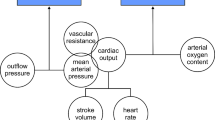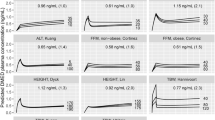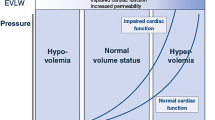Abstract
Fiberoptic endoscopy is practiced everyday in the field of gastroenterology and, for diagnostic purposes, carries a risk of complications and an estimated mortality of 1∶5,000, which is multiplied several times during interventional procedures. Half of these complications have a cardiopulmonary origin which may be anticipated by the use of pulse oximetry to measure hemoglobin saturation (SaO 2).
We studied 132 patients undergoing diagnostic or procedural endoscopic retrograde cholangiopancreatography (ERCP) under sedation, and 51 undergoing esophagogastroduodenoscopy (EGD) without sedation. In the ERCP group, SaO 2 fell from 95.7±2.4% (mean ±standard deviation) to 88.9±6.4% (p<0.001) with a corresponding rise in pulse from 95±19 to 116±18/min (p<0.001) followed by recovery. The largest falls followed positioning of the endoscope (rather than following administration of the sedative or the procedure), particularly during introduction of the endoscope within 1 minute of administering diazemuls (diazepam). The EGD group also had a fall in SaO 2 (97.3±1.9% to 93.9±3.3%,p<0.001), although the patients were younger and undergoing shorter examinations. Again, the largest falls occurred 1 minute after introduction of the endoscope.
In subgroups of patients undergoing ERCP, analysis of respiratory patterns using spectral techniques and electrocardiogram during endoscopy (n=25), or peripheral perfusion using transcutaneous oximetry and laser Doppler velocimetry (n=12) was undertaken. No correlations were found in relation to changes in SaO 2.
The cause of the fall in SaO 2 during endoscopy is multifactorial. It is known to be related to a fall in blood pressure and, although we could not demonstrate any obvious change in peripheral perfusion, this may still be occurring and affecting pulse oximetry readings which are less accurate in poor perfusion states. We recommend its use, however, during endoscopy and, after intravenous sedation, it might be safer to wait 2 minutes and document that the SaO 2 is satisfactory before introducing the endoscope.
Résumé
La fibroscopie est pratique courante en gastroentérologie. Tandis qu'elle présente, à des fins diagnostiques, des risques de complications et une mortalité de 1 pour 5,000, il faut multiplier plusieurs fois ce taux en cas d'endoscopie interventionelle (thérapeutique). La moitié des complications ont une origine cardiopulmonaire qu'on peut prévoir grâce aux gaz du sang pour mesurer la saturation de l'hémoglobine (SaO2).
Nous avons étudié 132 patients ayant eu une cholangiopancréaticographie endoscopique rétrograde (CPER) à visée soit diagnostique soit thérapeutique sous anesthésie vigile et 51 patients ayant eu une oesogastroduodénoscopie (OGD), cette fois-ci sans anesthésie vigile. Dans le groupe CPER, la SaO2 passait de 95.7±2.4% (m±ET) à 88.9±6.4% (p<0.001), avec une augmentation correspondante du pouls de 95±19 à 116±18 pulsations/min (p<0.001), suivie d'une normalisation. Les plus importantes baisses ont été enregistrées après la mise en place de l'endoscope plutôt qu'à l'administration de calmants ou à l'acte lui-mÊme, en particulier, lorsque l'endoscope a été introduit moins d'une minute après l'administration intraveineuse de diazemuls (diazéparn). Le groupe OGD avait aussi une chute de la SaO2 (97.3±1.9% à 93.9±3.3%,p<0.001), bien que les patients soient plus jeunes et qu'ils aient subi des examens plus courts. Ici encore, les chutes les plus importantes se sont produites une minute après l'introduction de l'endoscope.
Dans les sous-groupes de patients ayant eu une CPER, l'analyse soit de la fonction respiratoire avec une technique de photométrie de spectre et l'ECG pendant l'endoscopie (n=25), soit celle de la perfusion périphérique par l'oximétrie transcutanée et par la vélocimètrie Doppler/laser (n=12) a été entreprise. On n'a trouvé aucune corrélation en relation avec les modifications de la SaO2.
La cause de la chute de la SaO2 est multifactorielle. Elle est généralement attribuée à une chute de tension artérielle, et bien que nous ne puissions mettre en évidence aucun changement de la perfusion périphérique, une chute de tension artérielle peut se produire et affecter les données de l'oximètrie de pouls, qui est moins précise en état d'hypoperfusion. Malgré ce, nous recommandons son emploi pendant l'endoscopie, et nous pensons qu'après une sédation intraveineuse, il est plus sûr d'attendre 2 minutes et de vérifier que la SaO2 soit satisfaisante avant d'introduire l'endoscope.
Resumen
La endoscopia de fibra óptica es práctica diaria en gastroenterología y realizada con propósitos diagnósticos conlleva un riesgo de complicaciones y una mortalidad estimada de 1∶5,000, lo cual se multiplica varias veces cuando se trata de procedimientos intervencionistas. La mitad de estas complicaciones tiene un origen cardiopulmonar, lo cual puede ser anticipado mediante el uso de oximetría de pulso para determinar la saturación de la hemoglobiha (SaO2).
Hemos estudiado 132 pacientes sometidos a CPER diagnóstica o intervencionista bajo sedación, y 51 sometidos a esofagogastroduodenoscopia (EGD) sin sedación. En el grupo del CPER la SaO2 descendió de 95.7±2.4% (m±sd) a 88.9±6.4% (p<0.001), con un correspondiente ascenso del pulso de 95±19 a 116±18/min (p<0.001), seguido de recuperación. Los mayores descensos se observaron en seguida de la colocación del endoscopio, más que de la administración del sedante o del procedimiento, en especial la introducción del endoscopio dentro del primer minuto después de la medicación IV. El grupo sometido a EGD también exhibió descenso en la SaO2 (97.3±1.9% a 93.9±3.3%;p<0.001), aunque los pacientes eran más jóvenes y los procedimientos de más corta duración. De nuevo el mayor descenso se presentó 1 minuto después de la introducción del endoscopio.
En subgrupos de pacientes sometidos a CPER, se emprendió el análisis de los patrones respiratorios y del ECG durante la endoscopia (n=25), o el estudio de la perfusión periférica por oximetría transcutánea o velocimetría con laser Doppler (n=12). No se encontraron correlaciones con los cambios en SaO2.
La causa del descenso de la SaO2 durante la endoscopia es multifactorial. Se sabe que está relacionada con un descenso en la presión arterial y aunque no logramos demostrar ningÚn cambio obvio en la perfusión periférica, sí puede ocurrir y afectar los valores de la oximetría de pulso, los cuales son menos certeros en estados de mala perfusión. Sin embargo recomendamos su uso durante la endoscopia; después de sedación IV puede ser más seguro esperar 2 minutos y comprobar si la SaO2 es satisfactoria antes de introducir el endoscopio.
Similar content being viewed by others
References
Cotton, P.B., Williams, C.B.: Practical Gastrointestinal Endoscopy, Oxford, Blackwell, 1982
Schiller, K.F., Cotton, P.B., Salmon, P.R.: The hazards of digestive fibre-endoscopy: A survey of British experience. Gut13:1027, 1972
Silvis, S.E., Nebel, O., Rogers, G., Sugawa, C., Mandelstam, P.: Endoscopic complications. J.A.M.A.235:928, 1976
Mathew, P.K., Ona, F.V., Damevski, K., Wallace, W.A.: Arrythmias during upper gastrointestinal endoscopy. Angiology30:834, 1979
Katon, R.M.: Complications of upper gastrointestinal endoscopy in the gastrointestinal bleeder. Dig. Dis. Sci.26:47, 1981
Lieberman, D.A., Wuerker, C.K., Katon, R.M.: Cardiopulmonary risk of esophagogastro-duodenoscopy. Role of endoscope diameter and systemic sedation. Gastroenterology88:468, 1985
Habr-Gama, A., Waye, J.D.: Complications and Hazards of gastrointestinal endoscopy. World J. Surg.13:193, 1989
Lancaster, J.F., Gotley, D., Bartolo, D.C.C., Leaper, D.J.: Hypoxia and hypotension during upper and lower gastrointestinal endoscopy. Aust. N.Z. J. Surg. (in press)
Reiertsen, O., Skjoto, J., Jacobsen, C.D., Rosseland, A.R.: Complications of fiberoptic gastrointestinal endoscopy—Five years experience in a central hospital. Endoscopy19:1, 1986
Buck, N., Devlin, H.B., Lunn, J.N.: The Report of a Confidential Enquiry into Perioperative Deaths, London, Nuffield Provincial Hospitals Trust, 1987
Hayward, S.R., Sugawa, C., Wilson, R.F.: Changes in oxygenation and pulse rate during endoscopy. Am. Surg.55:198, 1989
Bell, G.D., Bown, S., Morden, A., Coady, T., Logan, R.F.A.: Prevention of hypoxaemia during upper gastrointestinal endoscopy by means of oxygen via nasal cannulae. Lancet1:1022, 1987
Hanning, C.D.: Editorial. Monitoring oxygenation during anaesthesia. Br. J. Anaesthesiol.57:359, 1985
Cohen, D.E., Downes, J.J., Raphaely, R.C.: What Difference does Pulse Oximetry Make? Anesthesiology68:181, 1988
Nunn, J.F.: Oxygen levels during anaesthesia. In Applied Respiratory Physiology, 2nd edition, London, Butterworth, 1977
Tate, N.: Monitoring during sedation for endoscopy. Br. Med. J.297:561, 1988
Martin, D., Tweedle, D.: Monitoring during sedation for endoscopy. Br. Med. J.297:978, 1988
Taylor, M.B., Whitwam, J.G.: The current status of pulse oximetry. Anaesthesia41:943, 1986
Alexander, C.M., Teller, L.E., Gross, J.B.: Principles of pulse oximetry: Theoretical and practical considerations. Anesthesiol. Analg.68:368, 1988
Tremper, K.K., Shoemaker, W.C.: Transcutaneous oxygen monitoring of critically ill adults, with and without low flow states. Crit. Care Med.9:706, 1981
Brennan, S.S., Leaper, D.J.: The effect of antiseptics on the healing wound: A study using the rabbit ear chamber. Br. J. Surg.72:780, 1985
Billings, P.J., Leaper, D.J.: Colostomy blood flow measurement by laser Doppler velocimetry. Vasc. Surg.20:251, 1986
Brady, C.E., Harkleroad, L.E., Person, W.P.: Alterations in oxygen saturation and ventilation after intravenous sedation for peritoneoscopy. Arch. Intern. Med.149:1029, 1989
Author information
Authors and Affiliations
Rights and permissions
About this article
Cite this article
Al-Hadeedi, S., Leaper, D.J. Falls in hemoglobin saturation during ERCP and upper gastrointestinal endoscopy. World J. Surg. 15, 88–94 (1991). https://doi.org/10.1007/BF01658972
Issue Date:
DOI: https://doi.org/10.1007/BF01658972




